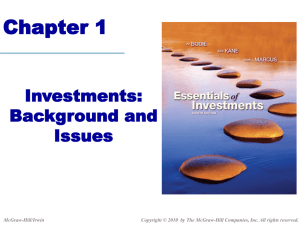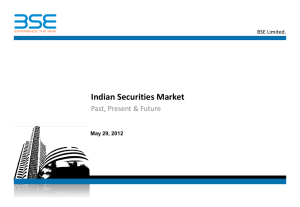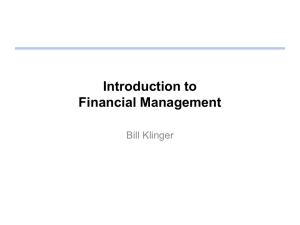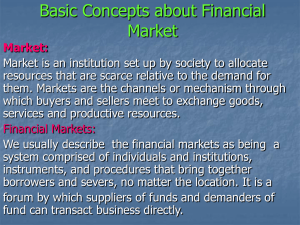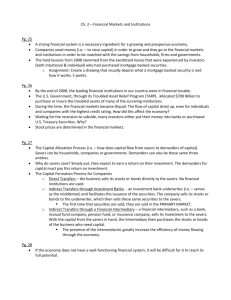Mutual Funds
advertisement
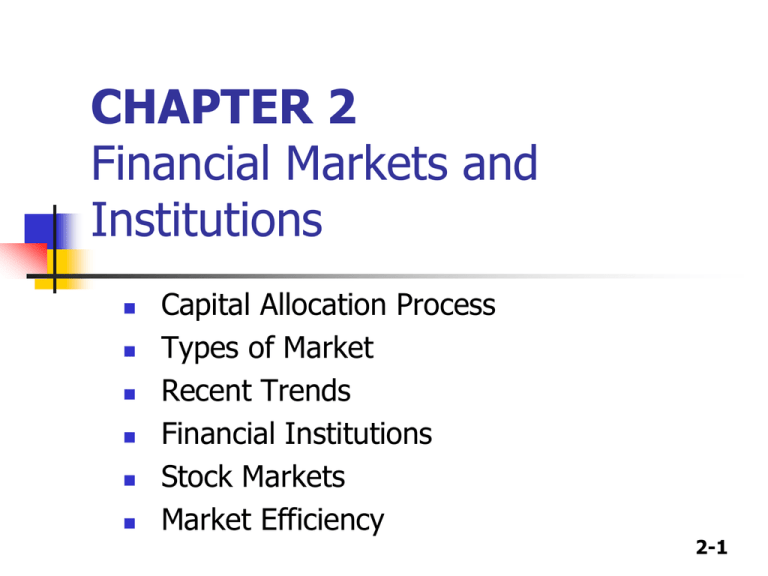
CHAPTER 2 Financial Markets and Institutions Capital Allocation Process Types of Market Recent Trends Financial Institutions Stock Markets Market Efficiency 2-1 Capital Allocation Process Businesses, individuals, and governments often need to raise capital. Some individuals and firms have incomes that exceed their current expenditure. The surplus fund they have are accumulated as savings for some future use. 2-2 Transfer of Funds In a well-functioning economy, capital flows efficiently from those with surplus capital to those who need it. Three ways the capital is transferred: Direct transfer Indirect transfers through investment bankers Indirect transfers through financial intermediary. 2-3 Transfer of Funds 2-4 Types of Markets Physical asset Markets VS Financial asset Markets Spot Markets VS Futures Markets Money Markets VS Capital Markets Primary Markets VS Secondary Markets Private Markets VS Public Markets 2-5 Physical Asset Markets VS Financial Asset Markets Physical asset Markets are for products that has physical substance (size, shape). For example: wheat, cars, real estate, computers, machineries etc. Thus it is also called “tangible” or “real” assets market Financial asset Markets deal with financial securities like stocks, bonds, notes, mortgage, derivative. 2-6 Spot Markets VS Futures Markets Spot Markets are markets in which assets are bought or sold for “on-the-spot” delivery. Spot market prices are the current prices of the asset. Futures Markets are markets in which participants agree today to buy or sell an asset at some future date at a particular price. Prices at the futures market are estimated. Transactions in the futures market can reduce risk. This is called hedging. 2-7 Money Markets VS Capital Markets Money Markets are the markets for short-term, highly liquid debt securities. NY, London and Tokyo money markets are the largest in the world. Capital Markets are the markets for intermediate or long-term debt and equity securities. All the stock exchanges in the world are examples of Capital Market. 2-8 2-9 Primary Markets VS Secondary Markets Primary Markets are the markets in which corporations raise new capital. When securities are sold for the first time directly from the issuer it is a transaction in the primary market. Secondary Markets are markets in which existing, already outstanding, securities are traded among investors. It is the place where securities are sold “second-hand” 2-10 Types of Transactions Outstanding shares of established publicly owned companies that are traded in the secondary market (second-hand stocks trading). Additional new shares issued and sold by established publicly owned companies in the primary market. This is called “seasoned offerings” Initial Public Offerings (IPO) made by companies who are selling shares for the first time in the stock exchange. This is called “going public”. 2-11 Private Markets VS Public Markets Private Markets are markets where transactions are negotiated directly between buyer and seller. These deals are very customized. Example: bank loans, insurance etc. Public Market are markets in which standardized contracts are traded on organized exchanges. Large number of buyers and sellers hold similar securities in public markets 2-12 Recent Trends Some recent trends in financial markets are: Use of technology Globalization of banking and commerce Deregulation Increased Competition Increased use of derivative securities 2-13 Financial Institutions These are companies who act as an intermediary in between the investors and borrowers. Not involved in direct fund transfers. Most of them earns through either commissions or underwriting 2-14 Financial Institutions Commercial banks Investment banks Financial services corporations Mutual Funds Credit Unions Pension Funds Insurance Companies Exchange Traded Funds Hedge Funds Private Equity Companies 2-15 Investment Banks Investment banks are an organization that underwrites and distributes new investment securities and helps business obtain funds. Sometimes they also participate in investment with their own share of funds along with their client investors. They sometimes help the corporations to design the securities with features that are currently attractive to investors. 2-16 Commercial Banks Commercial banks are the traditional “departmental store” of finance serving a variety of savers (deposits) and borrowers (loans). Securitization: The process of pooling mortgages or other types of loans and then selling claims or securities against that pool in the secondary market. Example: MBS In every country there is a central bank who monitors and guides all the other commercial banks. Example: Bangladesh Bank, Federal Reserve of USA. 2-17 Financial Services Corporation Financial Services Corporation are large conglomerates that combine many different financial institutions within a single corporation. For example Citigroup owns Citibank (commercial bank), Smith Barney (investment bank & brokerage house), insurance companies, and leasing companies. 2-18 Mutual Funds Mutual Funds are organizations that pool investor funds to purchase financial securities and thus divides the risk and achieve economies of scale in security analysis and trading costs. Money market funds are mutual funds invested only in instruments traded in money market. 2-19 Insurance Companies Insurance Companies take savings in the form of annual premiums against a particular asset. They invest these funds in stocks, bonds, real estate, mortgages etc and make payments to the insured parties in case of the asset being stolen or broken. 2-20 Stock Market The most active secondary market and most important to financial managers is the stock market. There are two basic types of Stock Markets: Physical Location Stock Exchange Over-the-counter (OTC) Market/Dealer Market 2-21 Physical Location Exchange Physical Location Exchange: Formal Organizations having tangible physical locations that conduct trades of designated (listed) securities. Example: New York Stock Exchange (NYSE), Dhaka Stock Exchange (DSE). Sells trading license or “seats” to brokers which gives them the right to trade for the investors. 2-22 Over-the-Counter Markets Over-the-counter (OTC) markets are a large collection of brokers and dealers, connected electronically by telephones and computers, that provides for trading in unlisted securities. Example: National Association of Securities Dealers Automated Quotations (NASDAQ), Central Depository Bangladesh Limited (CDBL). Dealers state the bid price (buying price) of the stocks and the ask price (selling price). The difference between the two is the dealer’s profit, known as bid-ask spread. 2-23 Stock Market Efficiency When the prices of all the stocks are at equilibrium most of the time then that market is said to be efficient. A market in which prices are close to the intrinsic values is efficient. Intrinsic Values are calculated using information related to the security. The more information available in a market about all the securities the more efficient that market is 2-24




